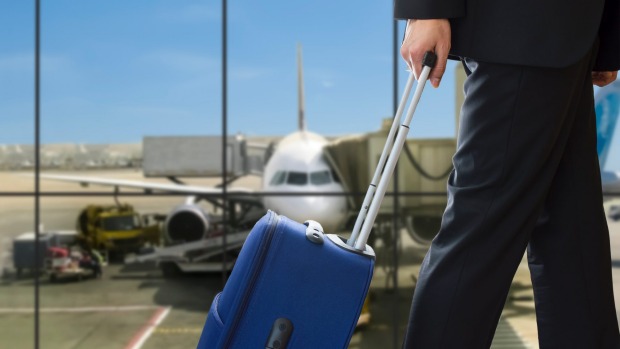
Having endured eight hours in airborne steerage, you arrive unrested, with knees that need oiling, your sinuses a desert. It was late night in your hometown when you departed. On arrival in another part of the world, it is someone else's morning.
The locals in this place - let's call it Milan, though Hong Kong would do, or Tokyo or London - having had their requisite shut-eye, will appear bright and chipper and freshly showered as they down the day's first dose of caffeine.
You pray your own clothes survived the journey in better shape than you did. No matter how tidily you packed your suit, following the guidelines we've all been taught - turn sleeves and jacket inside out, flip up lapel, fold jacket in half lengthwise, pad lightly with tissue paper - the immutable reality is this: Your clothes are going to emerge wrinkled. And you will make the best of a bad situation.
Or anyway that used to be the case.
Somehow, seemingly while no one was paying particular attention, a credible version of what used to be a sartorial oxymoron - the wrinkle-free travel suit - crept onto the scene.
Taking note of a revised work-world reality, that of an increasingly global and mobile business population, designers and manufacturers at points across the cost spectrum have applied themselves to making sure you do not arrive at that all-important meeting looking like a schlump.
Perhaps the best part of this new turn is that its underlying principles date not to the digital age but to an earlier time - say, the Upper Paleolithic Era, or whenever in deep history people first began spinning yarn.
"The three-ply yarn we use is woven specially for us at an Italian mill, and it is highly twisted," Frank Muytjens, the J. Crew menswear director, said recently, referring to a new line of popular Ludlow and Crosby style suits made purposely for travel and introduced in July.
Science has long understood that the molecular strands making up wool fiber are inherently flexible and springy. So, instinctively, has anyone who ever petted a lamb. "The more tightly you twist the fibre, the more it wants to go back to its original state," Muytjens said. And while the same cannot be said of the traveller, the mere fact of arriving at meetings in presentable clothes does tend to restore a jet-lagged traveler's battered spirits.
J. Crew is far from the only retailer venturing into this arena. Having provided the fashion industry with top-quality woollens for decades, the mills of Ermenegildo Zegna have turned out fabrics that are engineered to withstand suitcase incarceration and the red wine spills that are as inevitable a feature of business travel as neck pillows and Cinnabon. Recently the Zegna label itself has increased its offerings of smartly tailored travel suits in many weights and fabrications.
So, too, have mainstream labels from Burberry and Brooks Bros to cult favorites like Brunello Cucinelli and Luigi Bianchi Mantova, a stealth go-to for editors who follow the international menswear circuit.
Up in the nosebleed price section are offerings like an elegant dark-blue single-breasted Cucinelli suit with pick-stitched lapels, a ticket pocket subtly referring to such anachronisms of travel as ticket stubs, and an overall aura of anonymity.
"Even before we started to incorporate a travel jacket into our collections, I always wore an ultralight wool jacket that stayed practically intact no matter how much I wore it and moved," Brunello Cucinelli emailed from his headquarters in Solomeo, Italy. His personal experience with that jacket prompted him to branch out into suits, he added. The result, in wool and silk manufactured by Loro Piana, is both featherlight (the jacket weights 150 grams) and improbably durable.
"You can even fold it into a small compartment, shake it off and hang it, and it will return to its original wrinkle-free look," Cucinelli said.
Having road-tested a loaner suit, this reporter can confirm that the fabric possesses such miraculous properties of wrinkle-resistance, you could sleep on a park bench wearing one and wake up looking ready to start multitasking. And at $US4,285, that's how it should be.
"The way guys are dressing up more, everyone wants to be prepared and on their toes," the designer Todd Snyder said recently. "In the last five years, I've seen a return to the younger generation picking up where our fathers left off in terms of dressing the part, but with a new set of rules."
Those rules, said Nick Sullivan, fashion director of Esquire, accommodate revised conventions of business dress (like the now universally adopted cliche of blazers with jeans) and a wider latitude for socially acceptable rumpling (while conceding that for what the designer Tim Coppens called "ceremonial occasions," like weddings, funerals and job interviews, there will never be a substitute for a classic suit).
"A man can wear an unlined blazer off the plane, and if it's a bit creased that's part of the look," said Sullivan, who customarily wears either jacket or suit for travel, favoring unlined, garment-dyed $700 jackets from L.B.M. 1911 or the sleek $1,300 travel suits from Luigi Bianchi Mantova, made from so-called high-twist woolens produced by Zegna mills.
"It used to be that people put Lycra in travel suits so they held their shape," Snyder explained with considerable distaste. "Now there are enough ways you can do it within the yarn, twisting it a little bit tighter - almost like loading a spring."
The yarn woven to produce Snyder's newly introduced $795 single-breasted travel suit is so peppy, he claimed, you can wad it up into a ball.
Rather than taking Snyder at his word, I stuffed the jacket into my gym bag and promptly forgot about it. Days later, I discovered it wedged between a pair of Stan Smiths and some gym shorts. I yanked it out, gave it a quick shake and some airing. Then I put it on and wore it to a business lunch.
THE NEW YORK TIMES